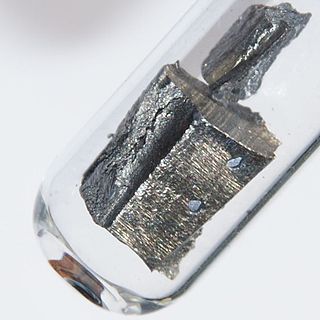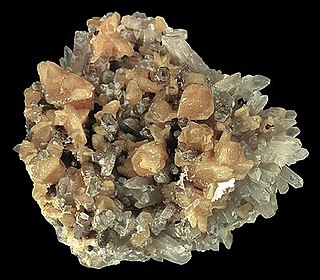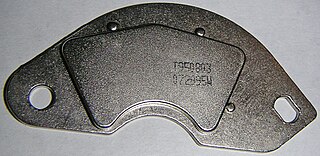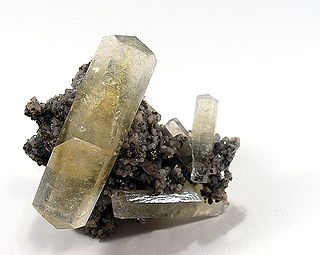
Dysprosium is a chemical element; it has symbol Dy and atomic number 66. It is a rare-earth element in the lanthanide series with a metallic silver luster. Dysprosium is never found in nature as a free element, though, like other lanthanides, it is found in various minerals, such as xenotime. Naturally occurring dysprosium is composed of seven isotopes, the most abundant of which is 164Dy.

Neodymium is a chemical element; it has symbol Nd and atomic number 60. It is the fourth member of the lanthanide series and is considered to be one of the rare-earth metals. It is a hard, slightly malleable, silvery metal that quickly tarnishes in air and moisture. When oxidized, neodymium reacts quickly producing pink, purple/blue and yellow compounds in the +2, +3 and +4 oxidation states. It is generally regarded as having one of the most complex spectra of the elements. Neodymium was discovered in 1885 by the Austrian chemist Carl Auer von Welsbach, who also discovered praseodymium. It is present in significant quantities in the minerals monazite and bastnäsite. Neodymium is not found naturally in metallic form or unmixed with other lanthanides, and it is usually refined for general use. Neodymium is fairly common—about as common as cobalt, nickel, or copper—and is widely distributed in the Earth's crust. Most of the world's commercial neodymium is mined in China, as is the case with many other rare-earth metals.

The rare-earth elements (REE), also called the rare-earth metals or rare earths or, in context, rare-earth oxides, and sometimes the lanthanides, are a set of 17 nearly indistinguishable lustrous silvery-white soft heavy metals. Compounds containing rare earths have diverse applications in electrical and electronic components, lasers, glass, magnetic materials, and industrial processes.

Monazite is a primarily reddish-brown phosphate mineral that contains rare-earth elements. Due to variability in composition, monazite is considered a group of minerals. The most common species of the group is monazite-(Ce), that is, the cerium-dominant member of the group. It occurs usually in small isolated crystals. It has a hardness of 5.0 to 5.5 on the Mohs scale of mineral hardness and is relatively dense, about 4.6 to 5.7 g/cm3. There are five different most common species of monazite, depending on the relative amounts of the rare earth elements in the mineral:

The mineral bastnäsite (or bastnaesite) is one of a family of three carbonate-fluoride minerals, which includes bastnäsite-(Ce) with a formula of (Ce, La)CO3F, bastnäsite-(La) with a formula of (La, Ce)CO3F, and bastnäsite-(Y) with a formula of (Y, Ce)CO3F. Some of the bastnäsites contain OH− instead of F− and receive the name of hydroxylbastnasite. Most bastnäsite is bastnäsite-(Ce), and cerium is by far the most common of the rare earths in this class of minerals. Bastnäsite and the phosphate mineral monazite are the two largest sources of cerium and other rare-earth elements.

Praseodymium is a chemical element; it has symbol Pr and the atomic number 59. It is the third member of the lanthanide series and is considered one of the rare-earth metals. It is a soft, silvery, malleable and ductile metal, valued for its magnetic, electrical, chemical, and optical properties. It is too reactive to be found in native form, and pure praseodymium metal slowly develops a green oxide coating when exposed to air.

A neodymium magnet (also known as NdFeB, NIB or Neo magnet) is a permanent magnet made from an alloy of neodymium, iron, and boron to form the Nd2Fe14B tetragonal crystalline structure. They are the most widely used type of rare-earth magnet.
Neodymium(III) chloride or neodymium trichloride is a chemical compound of neodymium and chlorine with the formula NdCl3. This anhydrous compound is a mauve-colored solid that rapidly absorbs water on exposure to air to form a purple-colored hexahydrate, NdCl3·6H2O. Neodymium(III) chloride is produced from minerals monazite and bastnäsite using a complex multistage extraction process. The chloride has several important applications as an intermediate chemical for production of neodymium metal and neodymium-based lasers and optical fibers. Other applications include a catalyst in organic synthesis and in decomposition of waste water contamination, corrosion protection of aluminium and its alloys, and fluorescent labeling of organic molecules (DNA).

The Arafura Sea lies west of the Pacific Ocean, overlying the continental shelf between Australia and Western New Guinea, which is the Indonesian part of the Island of New Guinea.
In petrology and geochemistry, an incompatible element is one that is unsuitable in size and/or charge to the cation sites of the minerals in which it is included. It is defined by a partition coefficient between rock-forming minerals and melt being much smaller than 1.

Carbonate minerals are those minerals containing the carbonate ion, CO2−
3.
The Australian Patrol Boat Group is a Force Element Group (FEG) of the Royal Australian Navy. It manages the Navy's patrol boats.

The Barberton Greenstone Belt is situated on the eastern edge of the Kaapvaal Craton in South Africa. It is known for its gold mineralisation and for its komatiites, an unusual type of ultramafic volcanic rock named after the Komati River that flows through the belt. Some of the oldest exposed rocks on Earth are located in the Barberton Greenstone Belt of the Eswatini–Barberton areas and these contain some of the oldest traces of life on Earth, second only to the Isua Greenstone Belt of Western Greenland. The Makhonjwa Mountains make up 40% of the Baberton belt. It is named after the town Barberton, Mpumalanga.
The Cook's swellshark is a little-known species of catshark, belonging to the family Scyliorhinidae. This shark is found in the Arafura Sea at a depth of 223–300 m (732–984 ft). It is a stocky-bodied shark with a short, broad head and a large mouth, and can be identified by the eight dark, pale-edged saddles along its grayish brown body and tail. The maximum known length of this species is 30 cm (12 in). Like other swellsharks, it can inflate itself with water or air when threatened.

The Arafura class is a class of offshore patrol vessels being built for the Royal Australian Navy (RAN). Initially proposed in the 2009 Defence White Paper and marked as procurement project SEA 1180, it was originally planned that 20 Offshore Combatant Vessels (OCV) would replace 26 vessels across four separate ship classes: the Armidale-class patrol boats, the Huon-class minehunters, the Leeuwin-class survey vessels, and the Paluma-class survey motor launches. Although having a common design, the ships would use a modular mission payload system to fulfill specific roles; primarily border patrol, mine warfare, and hydrographic survey. The 2013 Defence White Paper committed to the OCV project as a long-term goal, but opted in the short term for an accelerated procurement of an existing design to replace the Armidales, and life-extension refits for the other types. This resulted in the Offshore Patrol Vessel (OPV) project and the number of vessels reduced to 12. However, this was further increased to 14 when 2 further Mine Counter Measures variants were proposed under SEA 1905.

Lynas Rare Earths, Ltd. is an Australian rare-earths mining company with two major operations: a mining and concentration plant at Mount Weld in Western Australia, and the Lynas Advanced Materials Plant (LAMP) in Kuantan, Malaysia. The company was founded in the 1990s and is headquartered in Perth, Western Australia.
Michels Warren is a South Australian public relations firm headquartered on Melbourne Street, North Adelaide and established in 1978. The company claims to be Adelaide's oldest Australian-owned PR consultancy, specialises in "building and protecting brands" and serves clients from public, private and not-for-profit sectors. In 2003 Phil Martin acquired the firm from former owners Daryl Warren and Janet Grieve, merging with Maverick Media & PR. In 2013 the agency employed 14 staff. The firm works closely with Keito Events, which is managed by former Michels Warren employee, Kate Abrahams.

"Rare" is a song by American singer Selena Gomez from her third studio album of the same name (2020). It was released alongside the album as the third and final single off of its standard edition on January 10, 2020, by Interscope Records. The track was written by Gomez, Madison Love, Brett McLaughlin and its producers Sir Nolan and Simon Says. "Rare" is a pop and electropop song with lyrics exuding self-love and individuality. It peaked at number 30 on the US Billboard Hot 100. "Rare" was ranked as the 12th best song of the first half of 2020 by Billboard.
Praseodymium(III) fluoride is an inorganic compound with the formula PrF3, being the most stable fluoride of praseodymium.

MP Materials Corp. is an American rare-earth materials company headquartered in Las Vegas, Nevada. MP Materials owns and operates the Mountain Pass mine, the only operating rare earth mine and processing facility in the United States. The rare earth materials industry is dominated by China, which produces 60% of the world's rare earth elements and processes 90% of these materials, including imports from other countries. MP Materials focuses its production on Neodymium-Praseodymium (NdPr), a rare earth material used in high-strength permanent magnets that power the traction motors found in electric vehicles, robotics, wind turbines, drones and other advanced motion technologies. MP Materials is listed on the New York Stock Exchange under the ticker symbol "MP". As of December 2021, JHL Capital Group, QVT Financial and CEO James Litinsky were the company's three largest shareholders, with about 7.7% of the company owned by Shenghe Resources, a Chinese rare earth business located in Sichuan.














